Full text
PDF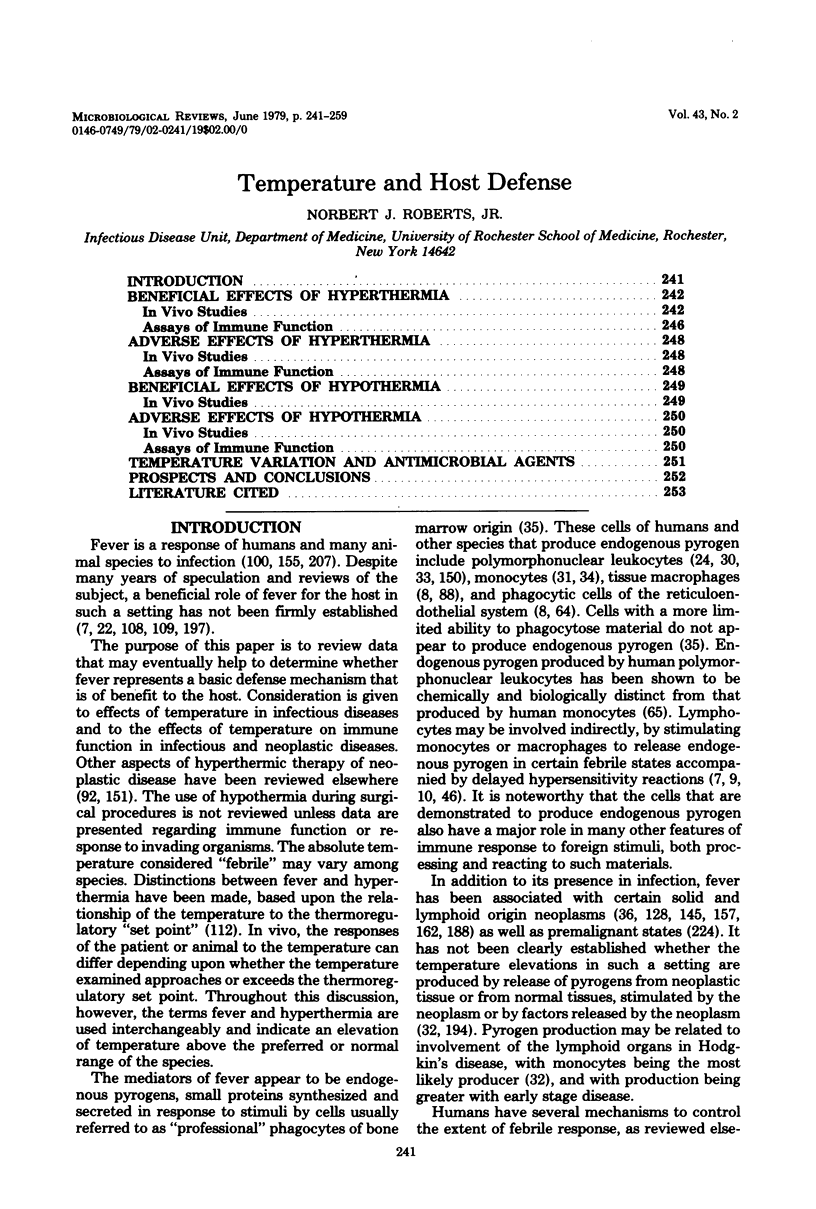
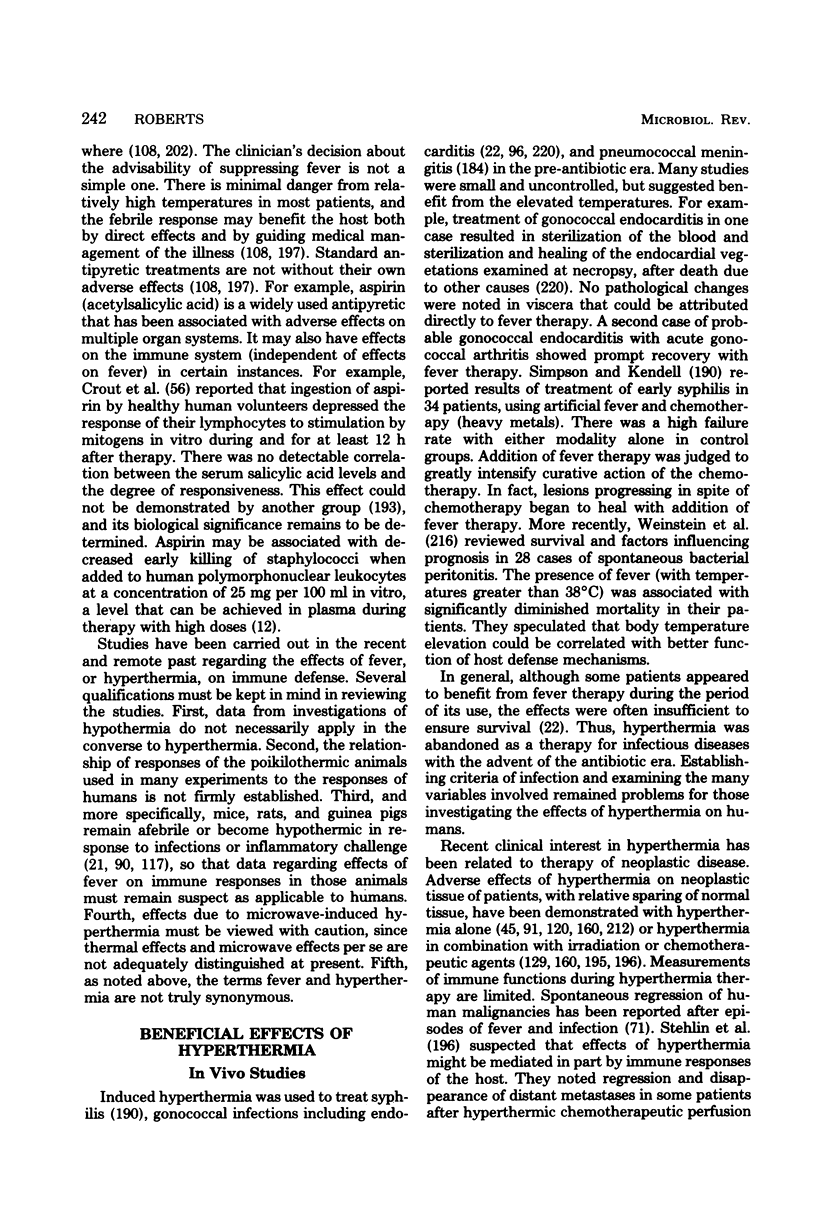
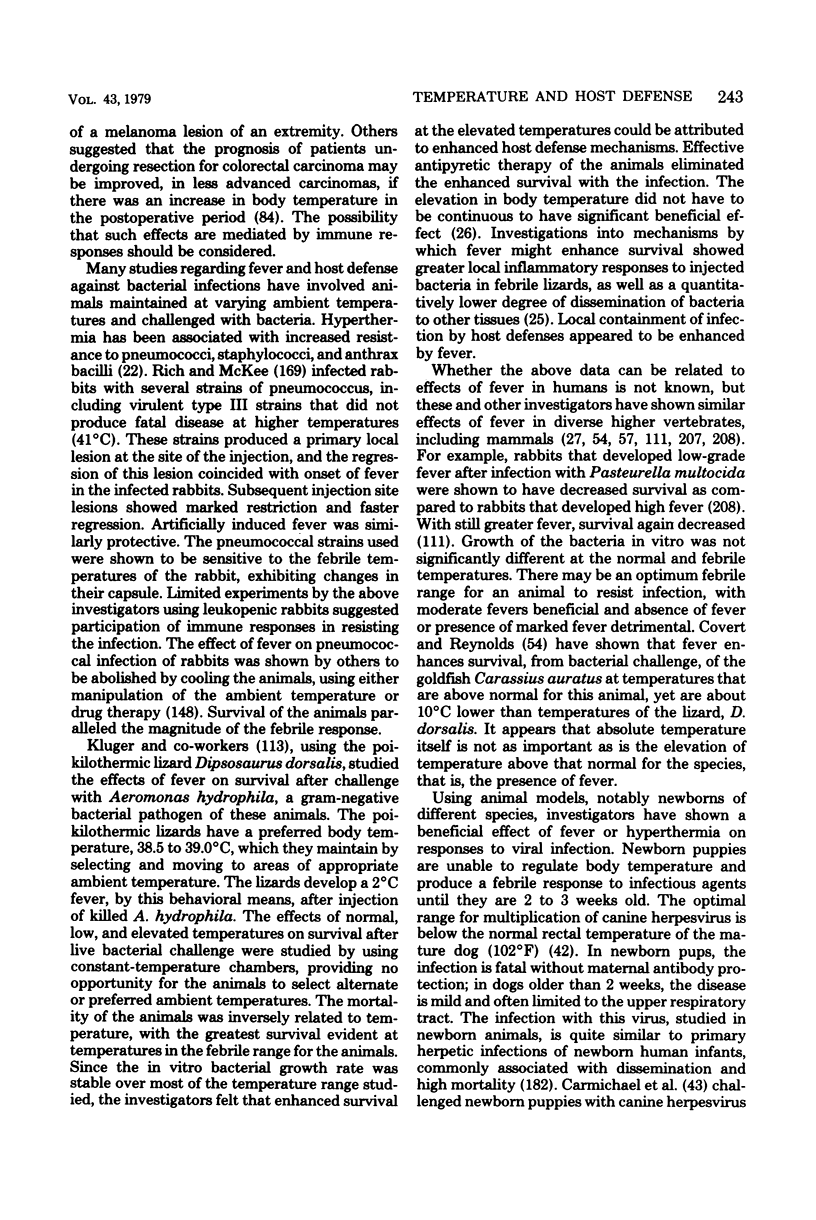
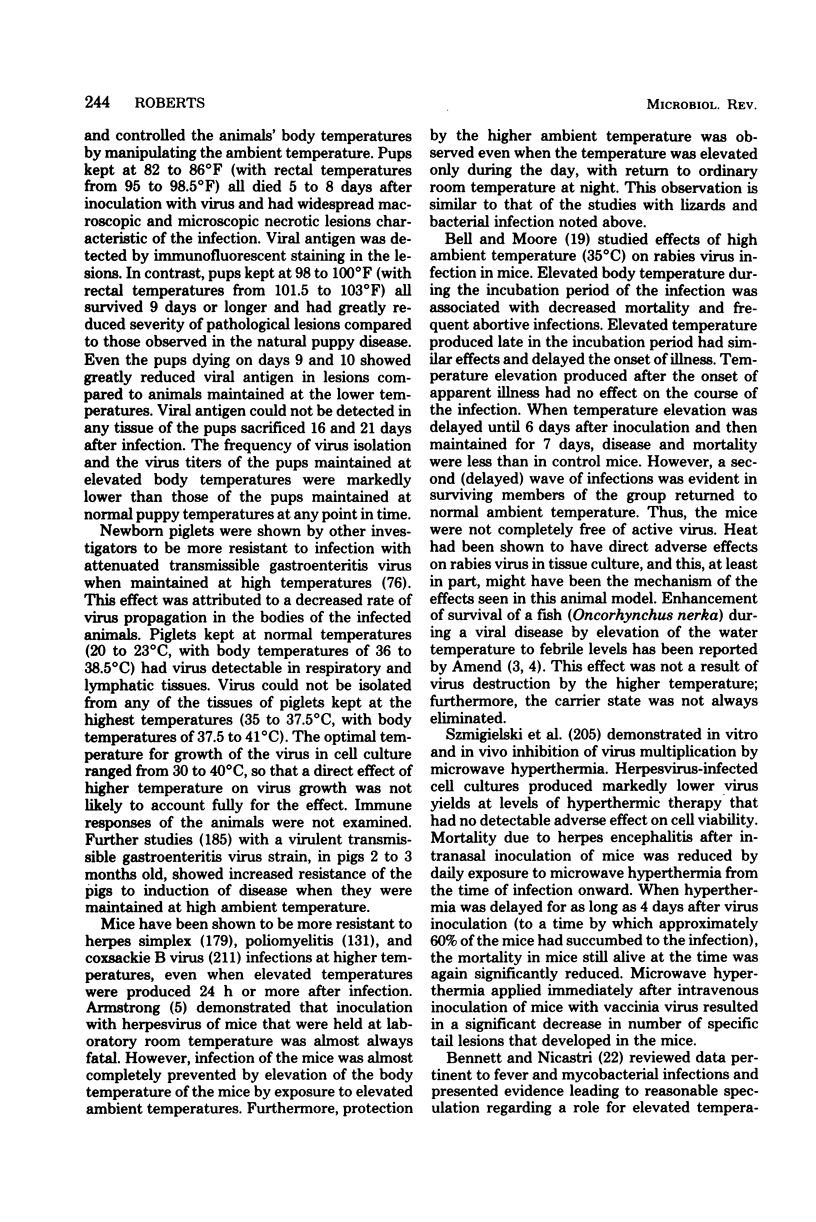
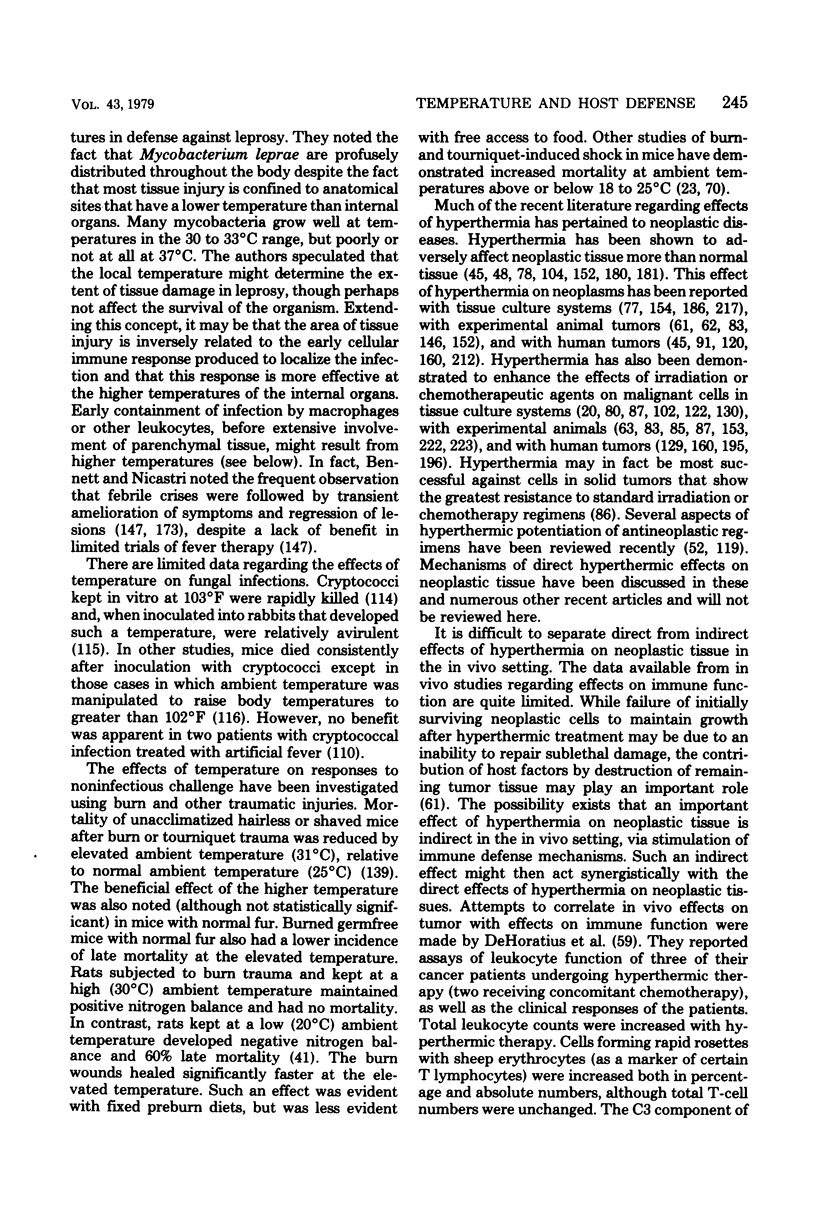
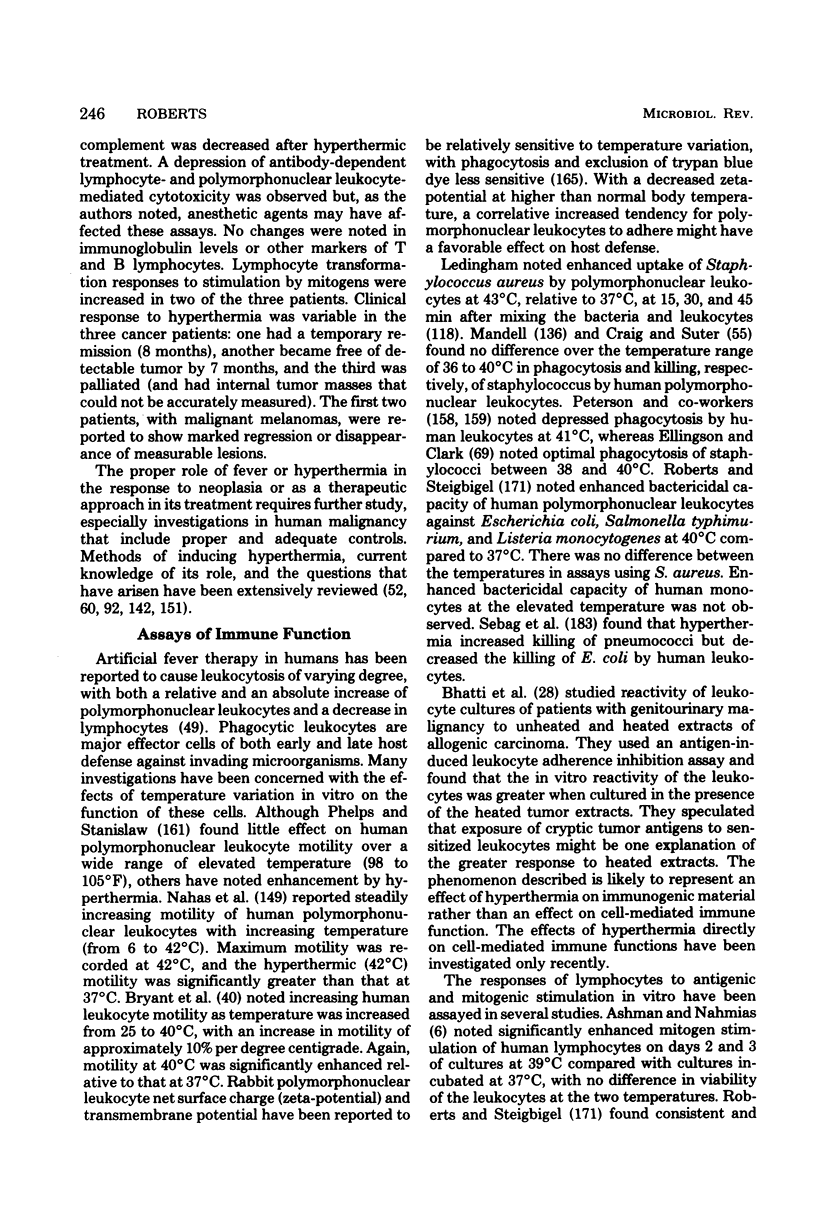
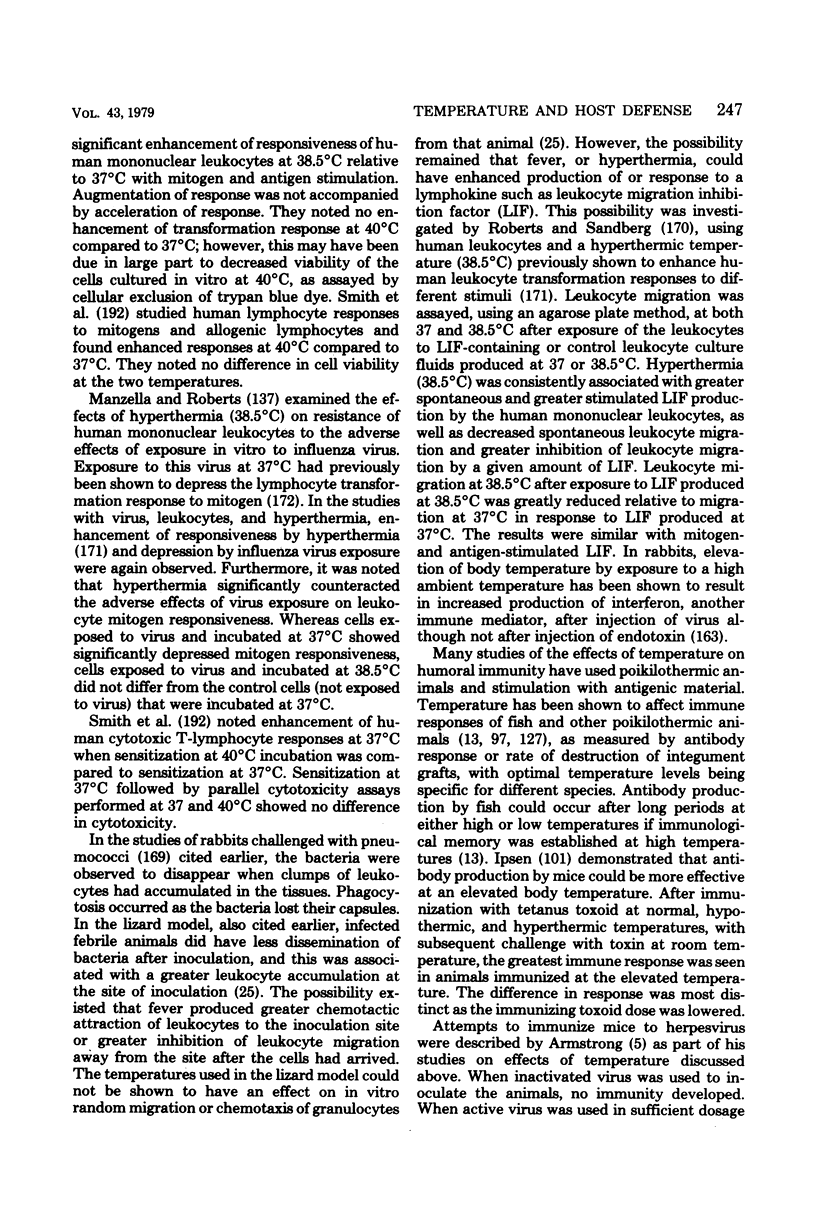
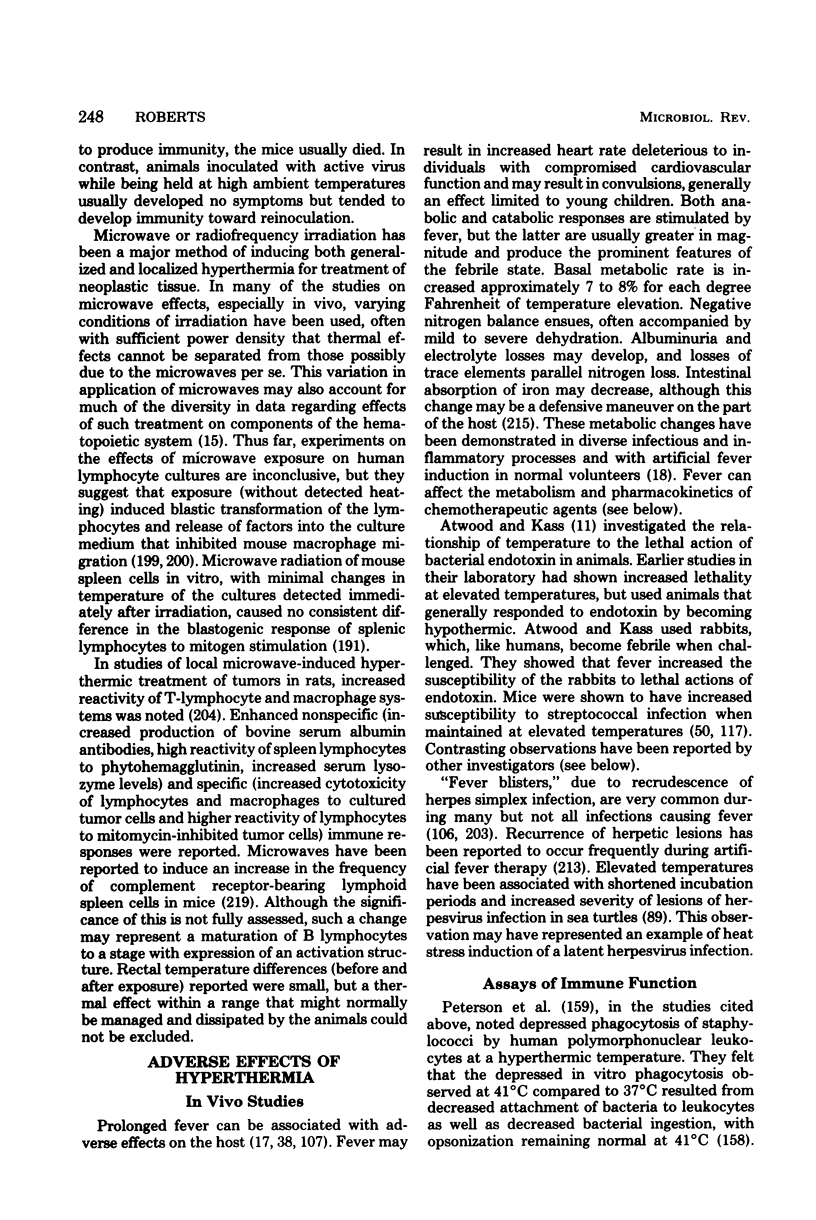
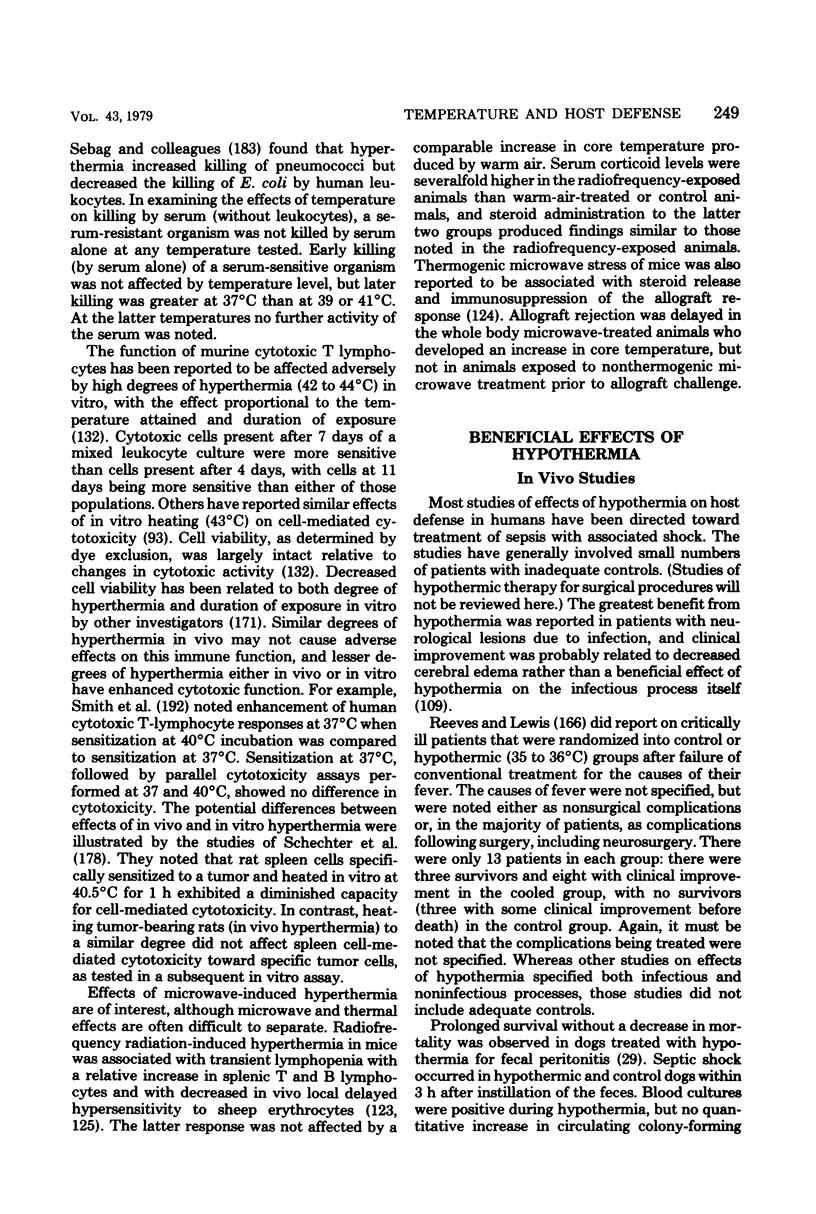
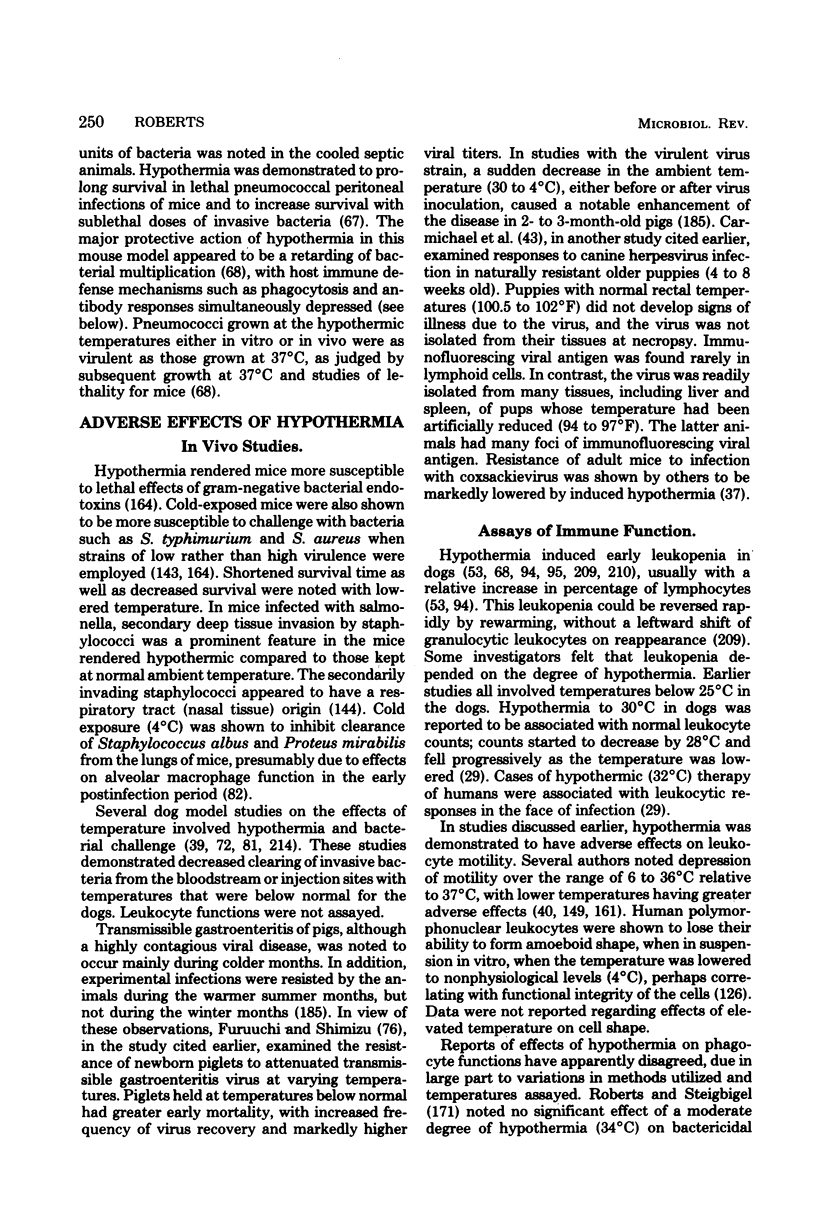
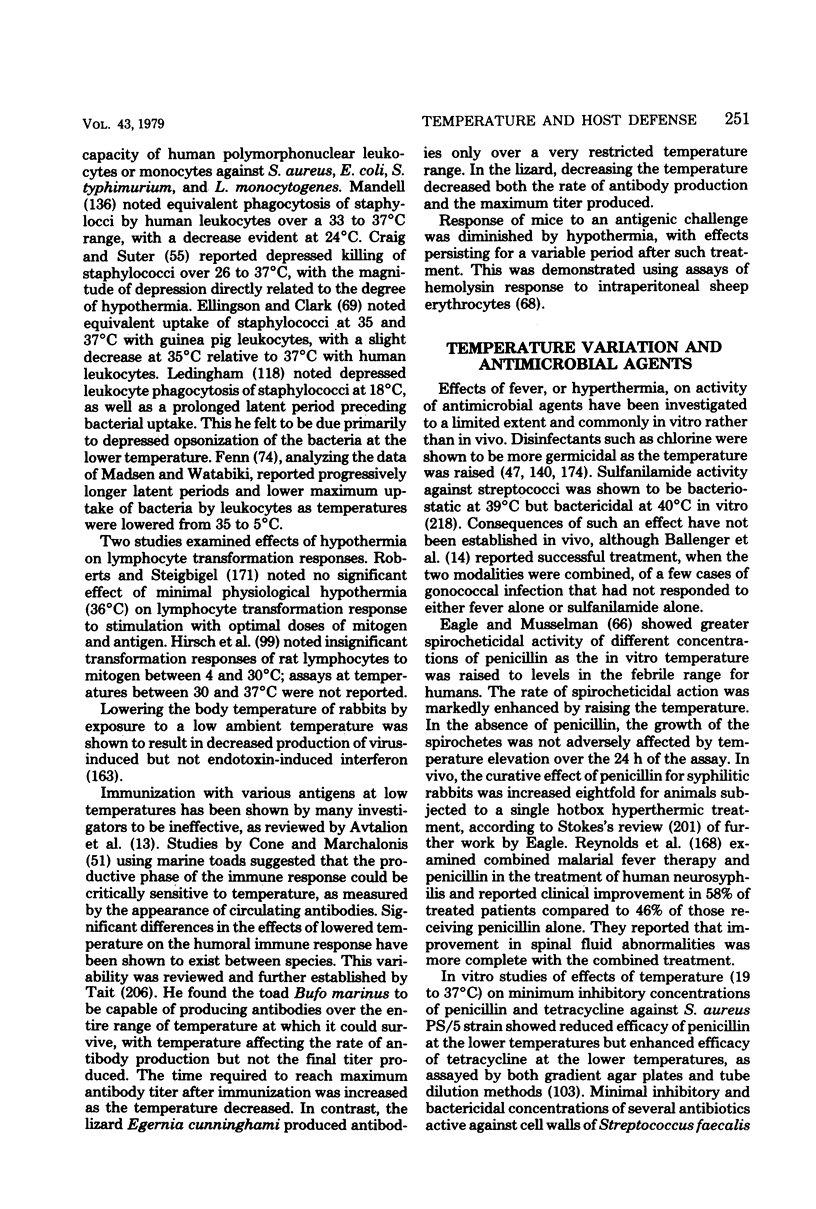
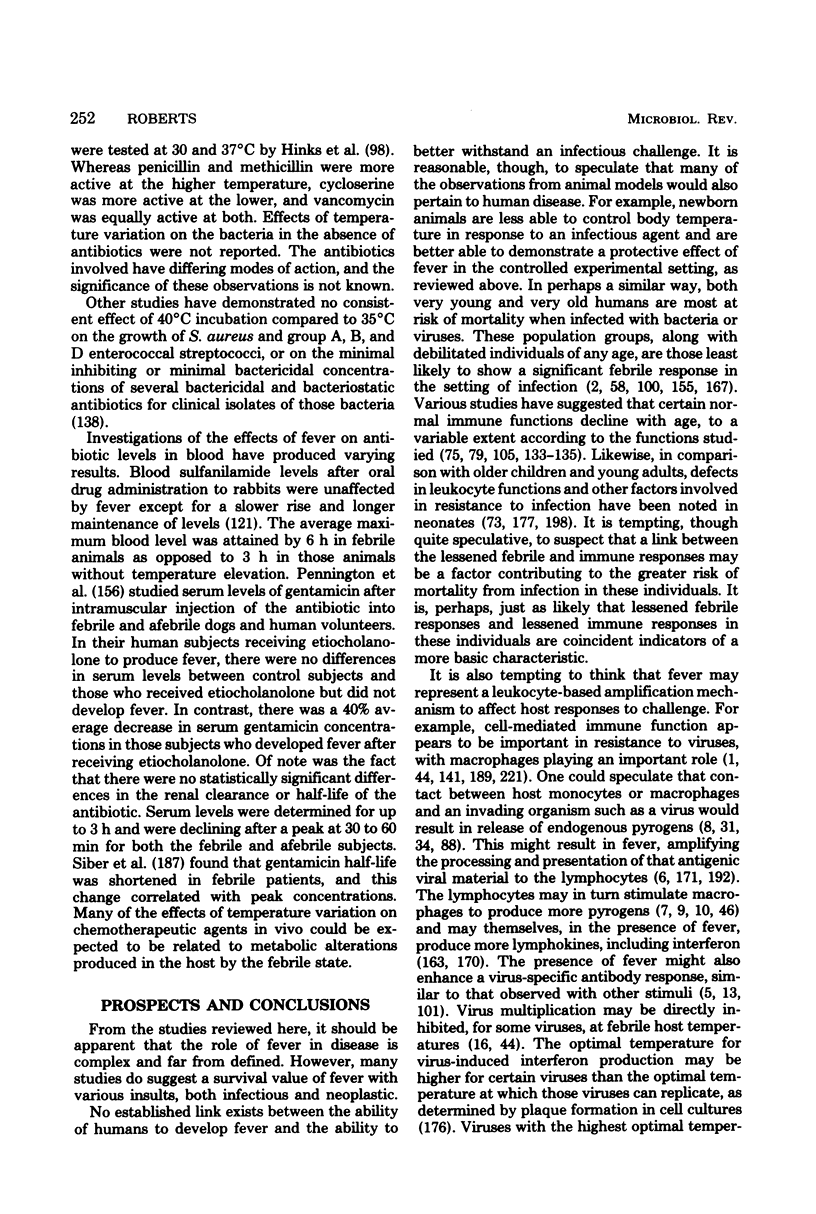
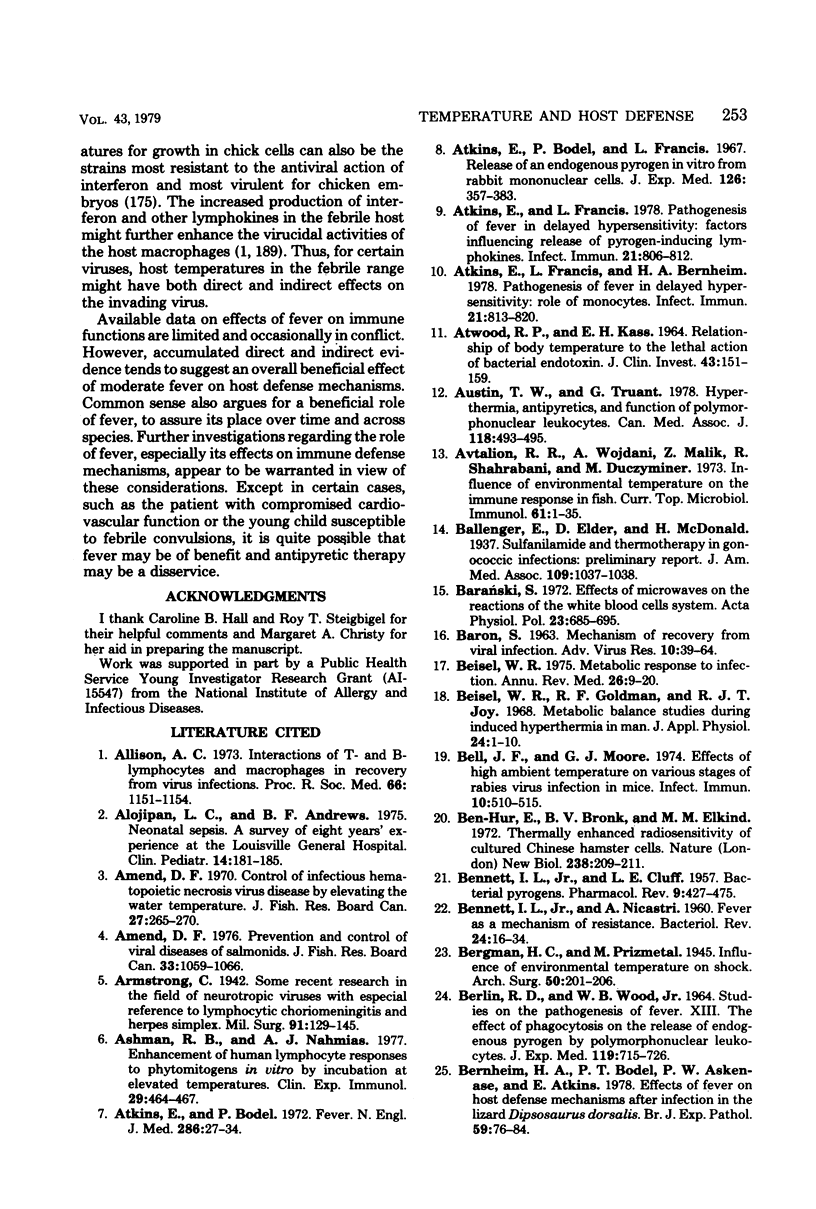
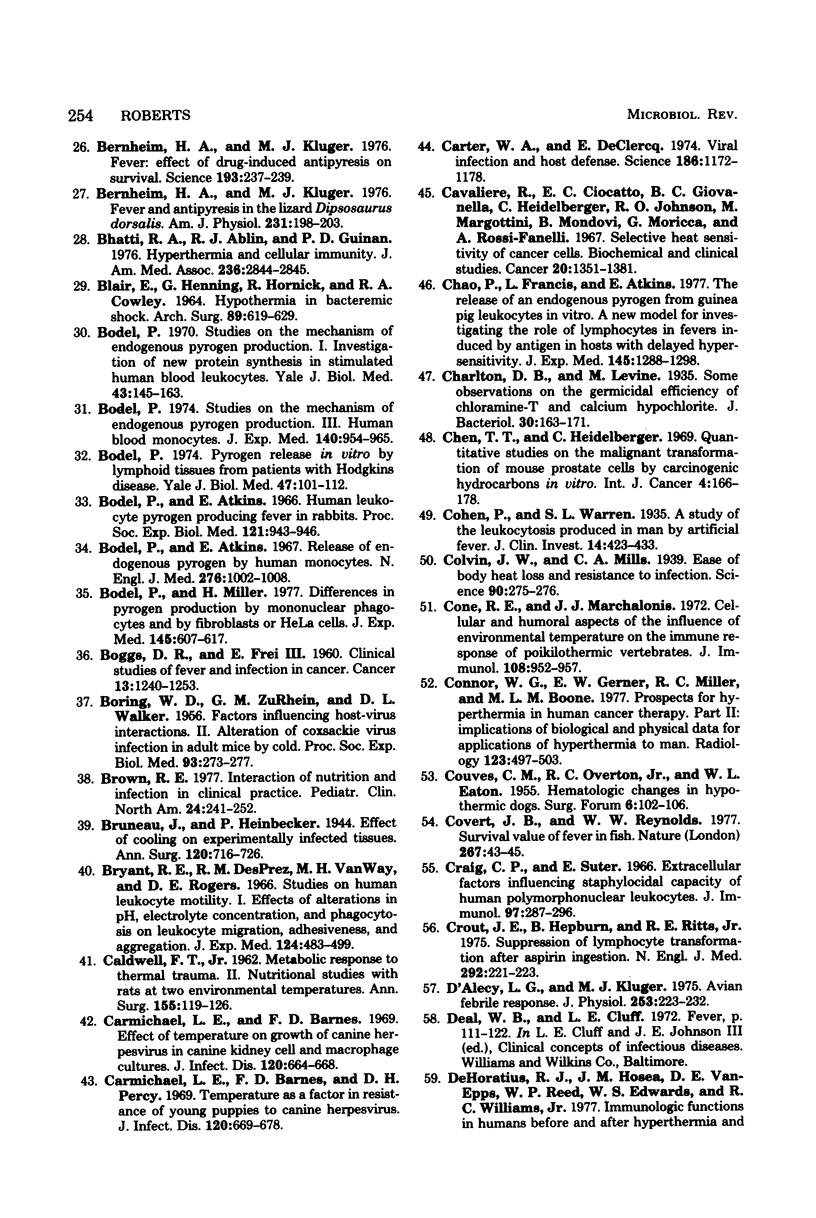
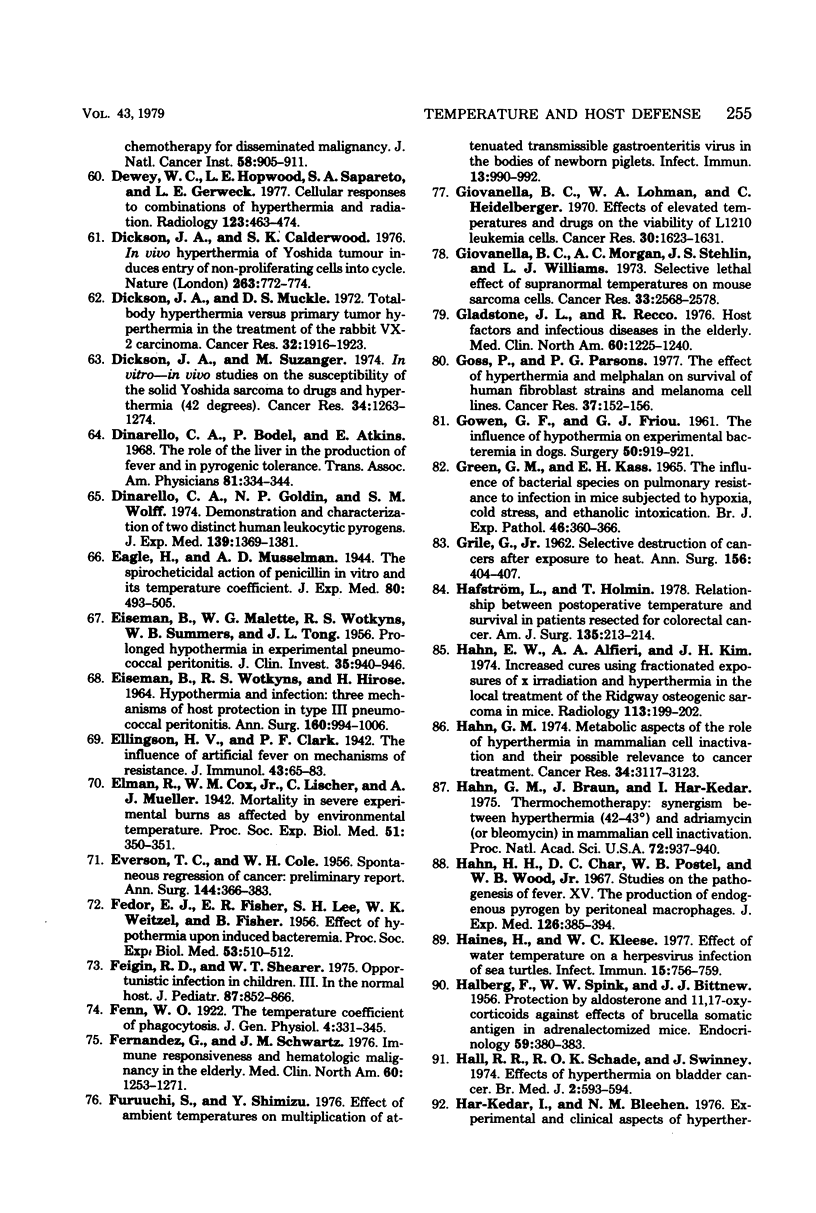
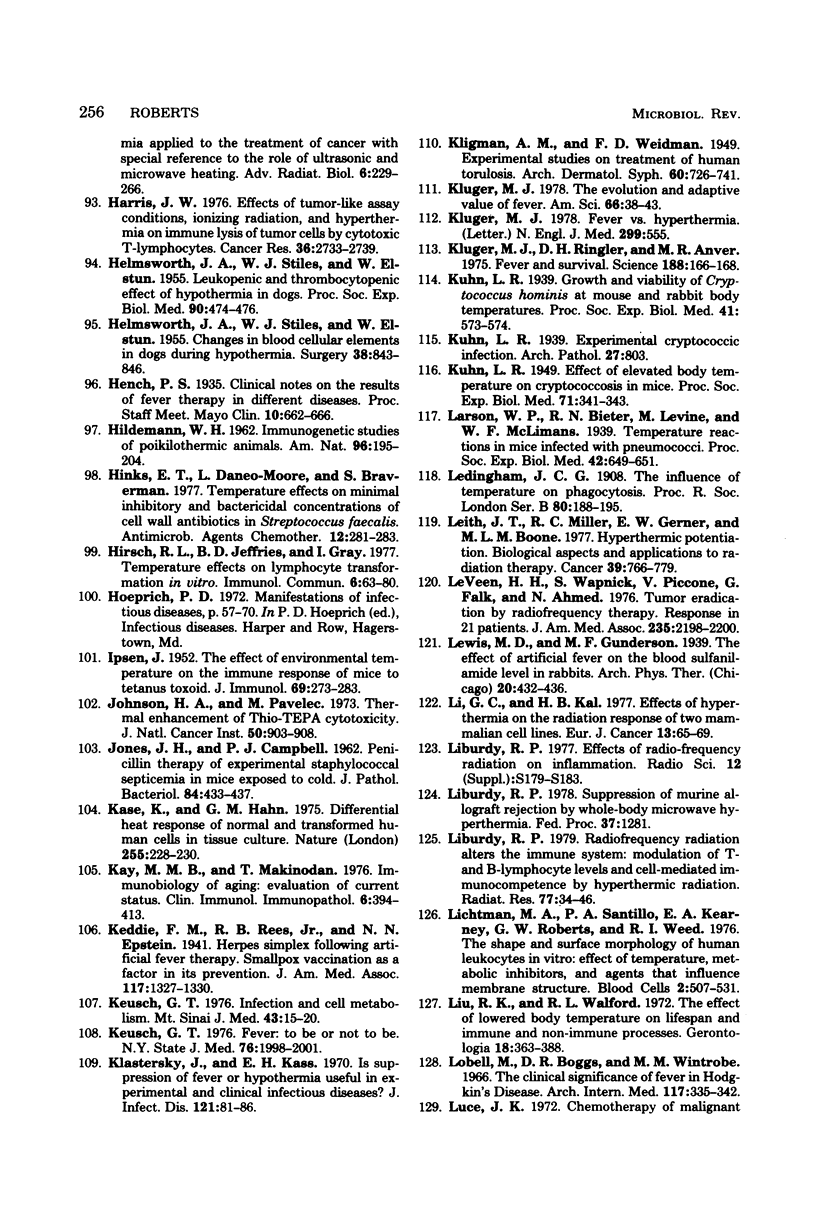
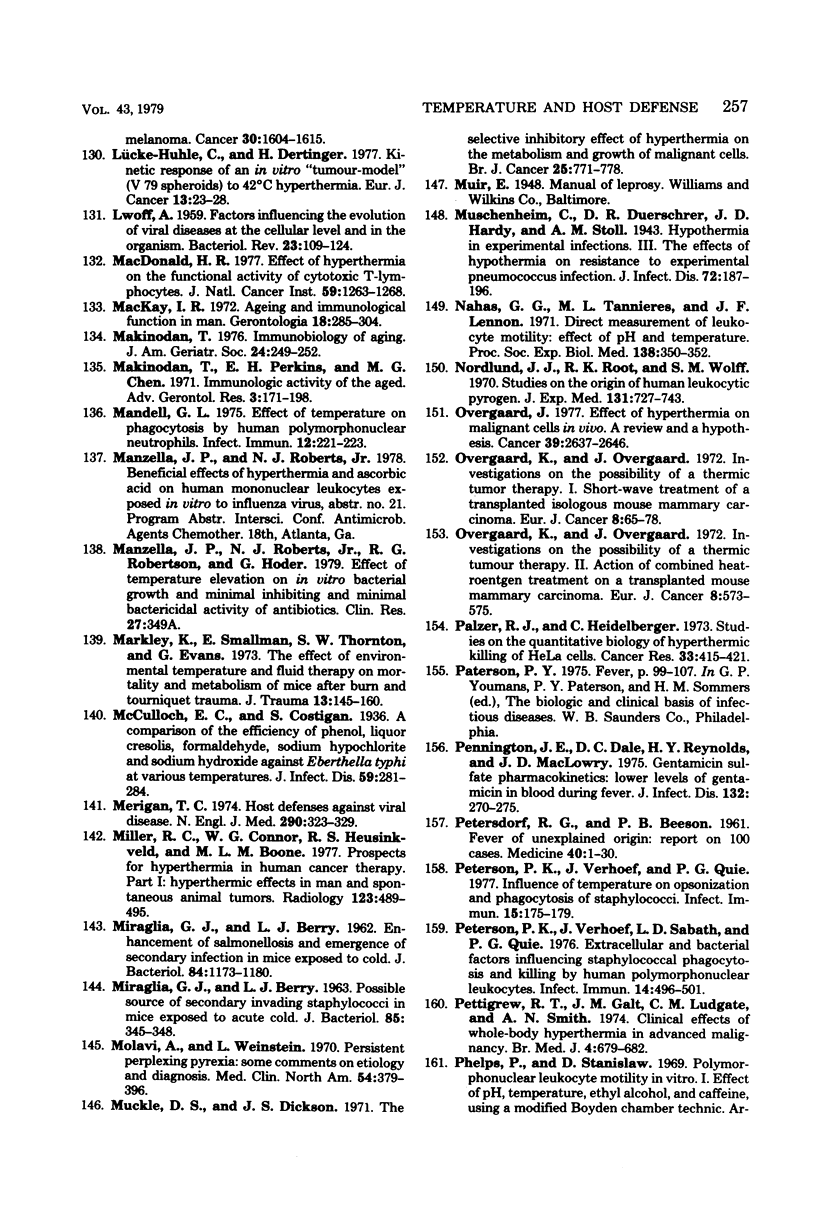
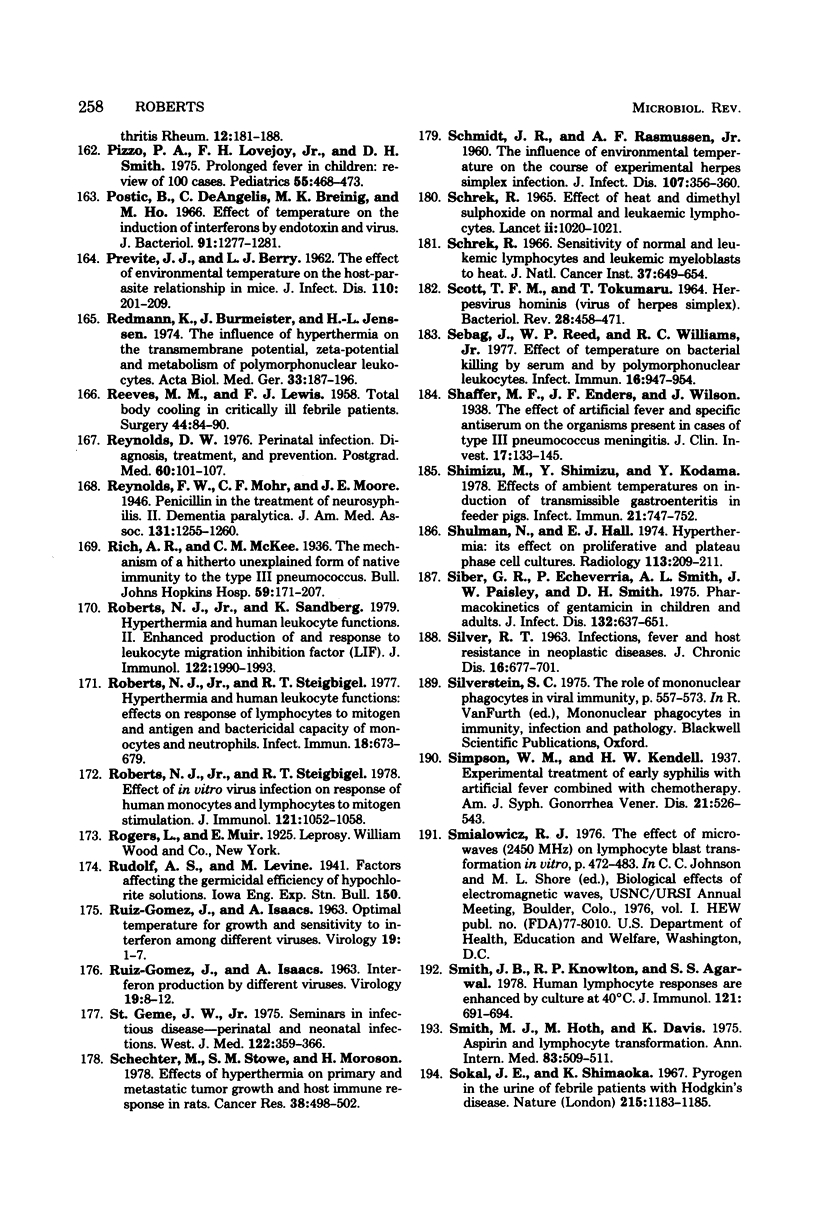
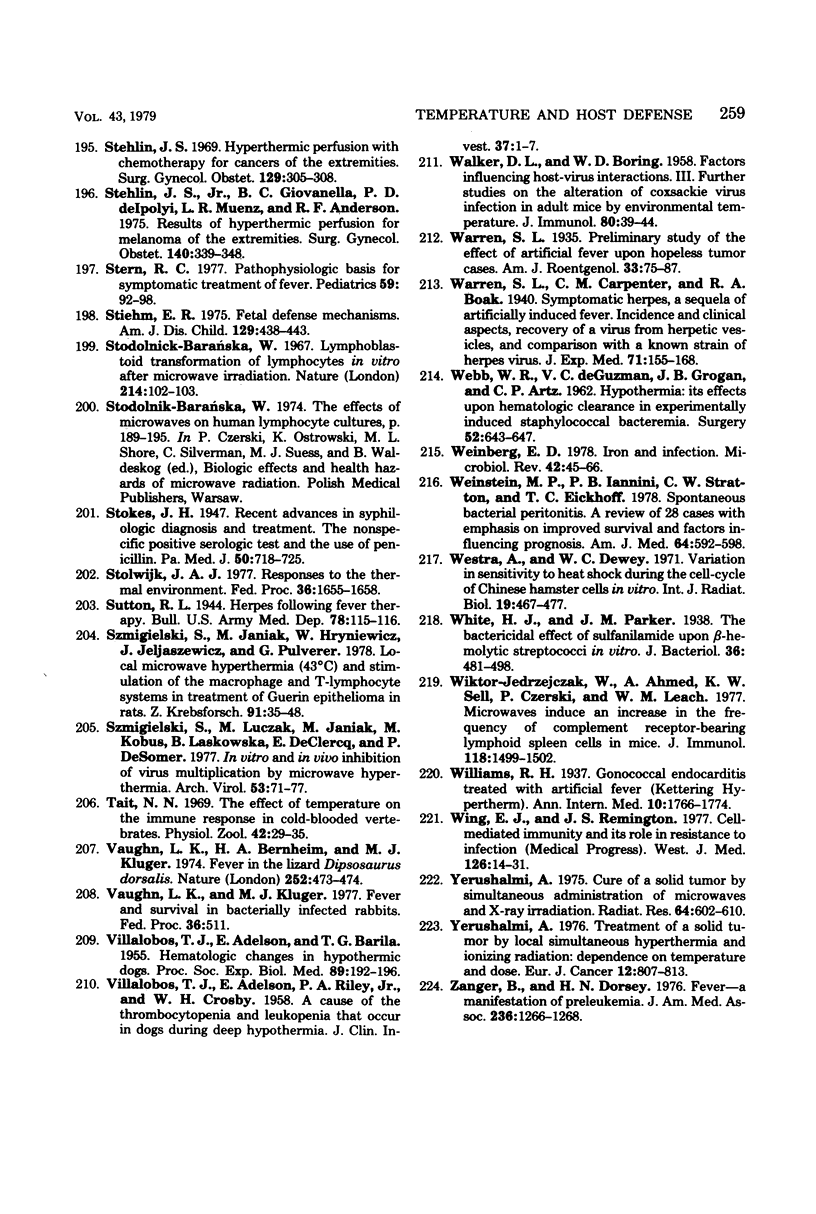
Selected References
These references are in PubMed. This may not be the complete list of references from this article.
- ATWOOD R. P., KASS E. H. RELATIONSHIP OF BODY TEMPERATURE TO THE LETHAL ACTION OF BACTERIAL ENDOTOXIN. J Clin Invest. 1964 Feb;43:151–169. doi: 10.1172/JCI104899. [DOI] [PMC free article] [PubMed] [Google Scholar]
- Allison A. C. Interactions of T-and B-lymphocytes and macrophages in recovery from virus infections. Proc R Soc Med. 1973 Dec;66(12):1151–1154. [PMC free article] [PubMed] [Google Scholar]
- Alojipan L. C., Andrews B. F. Neonatal sepsis. A survey of eight year's experience at the Louisville General Hospital. Clin Pediatr (Phila) 1975 Feb;14(2):181–185. doi: 10.1177/000992287501400209. [DOI] [PubMed] [Google Scholar]
- Ashman R. B., Nahmias A. J. Enhancement of human lymphocyte responses to phytomitogens in vitro by incubation at elevated temperatures. Clin Exp Immunol. 1977 Sep;29(3):464–467. [PMC free article] [PubMed] [Google Scholar]
- Atkins E., Bodel P. Fever. N Engl J Med. 1972 Jan 6;286(1):27–34. doi: 10.1056/NEJM197201062860109. [DOI] [PubMed] [Google Scholar]
- Atkins E., Bodel P., Francis L. Release of an endogenous pyrogen in vitro from rabbit mononuclear cells. J Exp Med. 1967 Aug 1;126(2):357–384. doi: 10.1084/jem.126.2.357. [DOI] [PMC free article] [PubMed] [Google Scholar]
- Atkins E., Francis L., Bernheim H. A. Pathogenesis of fever in delayed hypersensitivity: role of monocytes. Infect Immun. 1978 Sep;21(3):813–820. doi: 10.1128/iai.21.3.813-820.1978. [DOI] [PMC free article] [PubMed] [Google Scholar]
- Atkins E., Francis L. Pathogenesis of fever in delayed hypersensitivity: factors influencing release of pyrogen-inducing lymphokines. Infect Immun. 1978 Sep;21(3):806–812. doi: 10.1128/iai.21.3.806-812.1978. [DOI] [PMC free article] [PubMed] [Google Scholar]
- Austin T. W., Truant G. Hyperthermia, antipyretics and function of polymorphonuclear leukocytes. Can Med Assoc J. 1978 Mar 4;118(5):493–495. [PMC free article] [PubMed] [Google Scholar]
- Avtalion R. R., Wojdani A., Malik Z., Shahrabani R., Duczyminer M. Influence of environmental temperature on the immune response in fish. Curr Top Microbiol Immunol. 1973;61:1–35. doi: 10.1007/978-3-642-65531-9_1. [DOI] [PubMed] [Google Scholar]
- BARON S. MECHANISM OF RECOVERY FROM VIRAL INFECTION. Adv Virus Res. 1963;10:39–64. doi: 10.1016/s0065-3527(08)60696-x. [DOI] [PubMed] [Google Scholar]
- BENNETT I. L., Jr, CLUFF L. E. Bacterial pyrogens. Pharmacol Rev. 1957 Dec;9(4):427–479. [PubMed] [Google Scholar]
- BENNETT I. L., Jr, NICASTRI A. Fever as a mechanism of resistance. Bacteriol Rev. 1960 Mar;24(1):16–34. doi: 10.1128/br.24.1.16-34.1960. [DOI] [PMC free article] [PubMed] [Google Scholar]
- BERLIN R. D., WOOD W. B., Jr STUDIES ON THE PATHOGENESIS OF FEVER. 13. THE EFFECT OF PHAGOCYTOSIS ON THE RELEASE OF ENDOGENOUS PYROGEN BY POLYMORPHONUCLEAR LEUKOCYTES. J Exp Med. 1964 May 1;119:715–726. doi: 10.1084/jem.119.5.715. [DOI] [PMC free article] [PubMed] [Google Scholar]
- BITTNER J. J., HALBERG F., SPINK W. W. Protection by aldosterone and 11,17-oxycorticoids against effects of Brucella somatic antigen in adrenalectomized mice. Endocrinology. 1956 Sep;59(3):380–383. doi: 10.1210/endo-59-3-380. [DOI] [PubMed] [Google Scholar]
- BLAIR E., HENNING G., HORNICK R., COWLEY R. A. HYPOTHERMIA IN BACTEREMIC SHOCK. Arch Surg. 1964 Oct;89:619–629. doi: 10.1001/archsurg.1964.01320040035006. [DOI] [PubMed] [Google Scholar]
- BORING W. D., WALKER D. L., ZU RHEIN G. M. Factors influencing host-virus interactions. II. Alteration of Coxsackie virus infection in adult mice by cold. Proc Soc Exp Biol Med. 1956 Nov;93(2):273–277. doi: 10.3181/00379727-93-22730. [DOI] [PubMed] [Google Scholar]
- Beisel W. R., Goldman R. F., Joy R. J. Metabolic balance studies during induced hyperthermia in man. J Appl Physiol. 1968 Jan;24(1):1–10. doi: 10.1152/jappl.1968.24.1.1. [DOI] [PubMed] [Google Scholar]
- Beisel W. R. Metabolic response to infection. Annu Rev Med. 1975;26:9–20. doi: 10.1146/annurev.me.26.020175.000301. [DOI] [PubMed] [Google Scholar]
- Bell J. F., Moore G. J. Effects of high ambient temperature on various stages of rabies virus infection in mice. Infect Immun. 1974 Sep;10(3):510–515. doi: 10.1128/iai.10.3.510-515.1974. [DOI] [PMC free article] [PubMed] [Google Scholar]
- Ben-Hur E., Bronk B. V., Elkind M. M. Thermally enhanced radiosensitivity of cultured Chinese hamster cells. Nat New Biol. 1972 Aug 16;238(85):209–211. doi: 10.1038/newbio238209a0. [DOI] [PubMed] [Google Scholar]
- Bernheim H. A., Bodel P. T., Askenase P. W., Atkins E. Effects of fever on host defense mechanisms after infection in the lizard Dipsosaurus dorsalis. Br J Exp Pathol. 1978 Feb;59(1):76–84. [PMC free article] [PubMed] [Google Scholar]
- Bernheim H. A., Kluger M. J. Fever and antipyresis in the lizard Dipsosaurus dorsalis. Am J Physiol. 1976 Jul;231(1):198–203. doi: 10.1152/ajplegacy.1976.231.1.198. [DOI] [PubMed] [Google Scholar]
- Bernheim H. A., Kluger M. J. Fever: effect of drug-induced antipyresis on survival. Science. 1976 Jul 16;193(4249):237–239. doi: 10.1126/science.935867. [DOI] [PubMed] [Google Scholar]
- Bhatti R. A., Ablin R. J., Guinan P. D. Hyperthermia and cellular immunity. JAMA. 1976 Dec 20;236(25):2844–2845. [PubMed] [Google Scholar]
- Bodel P., Atkins E. Human leukocyte pyrogen producing fever in rabbits. Proc Soc Exp Biol Med. 1966 Mar;121(3):943–946. doi: 10.3181/00379727-121-30931. [DOI] [PubMed] [Google Scholar]
- Bodel P., Atkins E. Release of endogenous pyrogen by human monocytes. N Engl J Med. 1967 May 4;276(18):1002–1008. doi: 10.1056/NEJM196705042761803. [DOI] [PubMed] [Google Scholar]
- Bodel P., Miller H. Differences in pyrogen production by mononuclear phagocytes and by fibroblasts or HeLa cells. J Exp Med. 1977 Mar 1;145(3):607–617. doi: 10.1084/jem.145.3.607. [DOI] [PMC free article] [PubMed] [Google Scholar]
- Bodel P. Pyrogen release in vitro by lymphoid tissues from patients with Hodgkin's disease. Yale J Biol Med. 1974;47(2):101–112. [PMC free article] [PubMed] [Google Scholar]
- Bodel P. Studies on the mechanism of endogenous pyrogen production. I. Investigation of new protein synthesis in stimulated human blood leucocytes. Yale J Biol Med. 1970 Dec;43(3):145–163. [PMC free article] [PubMed] [Google Scholar]
- Bodel P. Studies on the mechanism of endogenous pyrogen production. III. Human blood monocytes. J Exp Med. 1974 Oct 1;140(4):954–965. doi: 10.1084/jem.140.4.954. [DOI] [PMC free article] [PubMed] [Google Scholar]
- Brown R. E. Interaction of nutrition and infection in clinical practice. Pediatr Clin North Am. 1977 Feb;24(1):241–252. doi: 10.1016/s0031-3955(16)33402-2. [DOI] [PubMed] [Google Scholar]
- Bruneau J., Heinbecker P. Effects of Cooling on Experimentally Infected Tissues. Ann Surg. 1944 Nov;120(5):716–726. doi: 10.1097/00000658-194411000-00004. [DOI] [PMC free article] [PubMed] [Google Scholar]
- Bryant R. E., DesPrez R. M., VanWay M. H., Rogers D. E. Studies on human leukocyte motility. I. Effects of alterations in pH, electrolyte concentration, and phagocytosis on leukocyte migration, adhesiveness, and aggregation. J Exp Med. 1966 Sep 1;124(3):483–499. doi: 10.1084/jem.124.3.483. [DOI] [PMC free article] [PubMed] [Google Scholar]
- COLE W. H., EVERSON T. C. Spontaneous regression of cancer: preliminary report. Ann Surg. 1956 Sep;144(3):366–383. doi: 10.1097/00000658-195609000-00007. [DOI] [PMC free article] [PubMed] [Google Scholar]
- COUVES C. M., EATON W. L., OVERTON R. C., Jr Hematologic changes in hypothermic dogs. Surg Forum. 1956;6:102–106. [PubMed] [Google Scholar]
- CRILE G., Jr Selective destruction of cancers after exposure to heat. Ann Surg. 1962 Sep;156:404–407. doi: 10.1097/00000658-196209000-00007. [DOI] [PMC free article] [PubMed] [Google Scholar]
- Caldwell F. T. Metabolic Response to Thermal Trauma: II. Nutritional Studies with Rats at Two Environmental Temperatures. Ann Surg. 1962 Jan;155(1):119–126. doi: 10.1097/00000658-196201000-00014. [DOI] [PMC free article] [PubMed] [Google Scholar]
- Carmichael L. E., Barnes F. D. Effect of temperature on growth of canine herpesvirus in canine kidney cell and macrophage cultures. J Infect Dis. 1969 Dec;120(6):664–668. doi: 10.1093/infdis/120.6.664. [DOI] [PubMed] [Google Scholar]
- Carmichael L. E., Barnes F. D., Percy D. H. Temperature as a factor in resistance of young puppies to canine herpesvirus. J Infect Dis. 1969 Dec;120(6):669–678. doi: 10.1093/infdis/120.6.669. [DOI] [PubMed] [Google Scholar]
- Carter W. A., De Clercq E. Viral infection and host defense. Science. 1974 Dec 27;186(4170):1172–1178. doi: 10.1126/science.186.4170.1172. [DOI] [PubMed] [Google Scholar]
- Cavaliere R., Ciocatto E. C., Giovanella B. C., Heidelberger C., Johnson R. O., Margottini M., Mondovi B., Moricca G., Rossi-Fanelli A. Selective heat sensitivity of cancer cells. Biochemical and clinical studies. Cancer. 1967 Sep;20(9):1351–1381. doi: 10.1002/1097-0142(196709)20:9<1351::aid-cncr2820200902>3.0.co;2-#. [DOI] [PubMed] [Google Scholar]
- Chao P., Francis L., Atkins E. The release of an endogenous pyrogen from guinea pig leukocytes in vitro: a new model for investigating the role of lymphocytes in fevers induced by antigen in hosts with delayed hypersensitivity. J Exp Med. 1977 May 1;145(5):1288–1298. doi: 10.1084/jem.145.5.1288. [DOI] [PMC free article] [PubMed] [Google Scholar]
- Charlton D. B., Levine M. Some Observations on the Germicidal Efficiency of Chloramine-T and Calcium Hypochlorite. J Bacteriol. 1935 Aug;30(2):163–171. doi: 10.1128/jb.30.2.163-171.1935. [DOI] [PMC free article] [PubMed] [Google Scholar]
- Chen T. T., Heidelberger C. Quantitative studies on the malignant transformation of mouse prostate cells by carcinogenic hydrocarbons in vitro. Int J Cancer. 1969 Mar 15;4(2):166–178. doi: 10.1002/ijc.2910040207. [DOI] [PubMed] [Google Scholar]
- Cohen P., Warren S. L. A STUDY OF THE LEUKOCYTOSIS PRODUCED IN MAN BY ARTIFICIAL FEVER. J Clin Invest. 1935 Jul;14(4):423–433. doi: 10.1172/JCI100693. [DOI] [PMC free article] [PubMed] [Google Scholar]
- Colvin J. W., Mills C. A. EASE OF BODY HEAT LOSS AND RESISTANCE TO INFECTION. Science. 1939 Sep 22;90(2334):275–276. doi: 10.1126/science.90.2334.275-a. [DOI] [PubMed] [Google Scholar]
- Cone R. E., Marchalonis J. J. Cellular and humoral aspects of the influence of environmental temperature on the immune response of poikilothermic vertebrates. J Immunol. 1972 Apr;108(4):952–957. [PubMed] [Google Scholar]
- Connor W. G., Gerner E. W., Miller R. C., Boone M. L. Prospects for hyperthermia in human cancer therapy. Part II: implications of biological and physical data for applications of hyperthermia to man. Radiology. 1977 May;123(2):497–503. doi: 10.1148/123.2.497. [DOI] [PubMed] [Google Scholar]
- Covert J. B., Reynolds W. W. Survival value of fever in fish. Nature. 1977 May 5;267(5606):43–45. doi: 10.1038/267043a0. [DOI] [PubMed] [Google Scholar]
- Craig C. P., Suter E. Extracellular factors influencing staphylocidal capacity of human polymorphonuclear leukocytes. J Immunol. 1966 Aug;97(2):287–296. [PubMed] [Google Scholar]
- Crout J. E., Hepburn B., Ritts R. E., Jr Suppression of lymphocyte transformation after aspirin ingestion. N Engl J Med. 1975 Jan 30;292(5):221–223. doi: 10.1056/NEJM197501302920501. [DOI] [PubMed] [Google Scholar]
- D'Alecy L. G., Kluger M. J. Avian febrile response. J Physiol. 1975 Dec;253(1):223–232. doi: 10.1113/jphysiol.1975.sp011188. [DOI] [PMC free article] [PubMed] [Google Scholar]
- Dewey W. C., Hopwood L. E., Sapareto S. A., Gerweck L. E. Cellular responses to combinations of hyperthermia and radiation. Radiology. 1977 May;123(2):463–474. doi: 10.1148/123.2.463. [DOI] [PubMed] [Google Scholar]
- Dickson J. A., Calderwood S. K. In vivo hyperthermia of Yoshida tumour induces entry of non-proliferating cells into cycle. Nature. 1976 Oct 28;263(5580):772–774. doi: 10.1038/263772a0. [DOI] [PubMed] [Google Scholar]
- Dickson J. A., Muckle D. S. Total-body hyperthermia versus primary tumor hyperthermia in the treatment of the rabbit VX-2 carcinoma. Cancer Res. 1972 Sep;32(9):1916–1923. [PubMed] [Google Scholar]
- Dickson J. A., Suzangar M. In vitro-in vivo studies on the susceptibility of the solid Yoshida sarcoma to drugs and hyperthermia (42 degrees). Cancer Res. 1974 Jun;34(6):1263–1274. [PubMed] [Google Scholar]
- Dinarello C. A., Bodel P. T., Atkins E. The role of the liver in the production of fever and in pyrogenic tolerance. Trans Assoc Am Physicians. 1968;81:334–344. [PubMed] [Google Scholar]
- Dinarello C. A., Goldin N. P., Wolff S. M. Demonstration and characterization of two distinct human leukocytic pyrogens. J Exp Med. 1974 Jun 1;139(6):1369–1381. doi: 10.1084/jem.139.6.1369. [DOI] [PMC free article] [PubMed] [Google Scholar]
- EISEMAN B., MALETTE W. G., SUMMERS W. B., TONG J. L., WOTKYNS R. S. Prolonged hypothermia in experimental pneumococcal peritonitis. J Clin Invest. 1956 Sep;35(9):940–946. doi: 10.1172/JCI103353. [DOI] [PMC free article] [PubMed] [Google Scholar]
- EISEMAN B., WOTKYNS R. S., HIROSE H. HYPOTHERMIA AND INFECTION: THREE MECHANISMS OF HOST PROTECTION IN TYPE 3 PNEUMOCOCCAL PERITONITIS. Ann Surg. 1964 Dec;160:994–1006. doi: 10.1097/00000658-196412000-00009. [DOI] [PMC free article] [PubMed] [Google Scholar]
- FEDOR E. J., FISHER B., FISHER E. R., LEE S. H., WEITZEL W. K. Effect of hypothermia upon induced bacteremia. Proc Soc Exp Biol Med. 1956 Dec;93(3):510–512. doi: 10.3181/00379727-93-22801. [DOI] [PubMed] [Google Scholar]
- Faff J. Badania nad odnowa acetylocholinoesterazy zwierzat zatrutych estrem pinakolinowym kwasu metylofluorofosfonowego. Acta Physiol Pol. 1972 Jul-Aug;23(4):685–695. [PubMed] [Google Scholar]
- Feigin R. D., Shearer W. T. Opportunistic infection in children. III. In the normal host. J Pediatr. 1975 Dec;87(6 Pt 1):852–866. doi: 10.1016/s0022-3476(75)80893-6. [DOI] [PubMed] [Google Scholar]
- Fernandez G., Schwartz J. M. Immune responsiveness and hematologic malignancy in the elderly. Med Clin North Am. 1976;60(6):1253–1271. doi: 10.1016/s0025-7125(16)31880-6. [DOI] [PubMed] [Google Scholar]
- Furuuchi S., Shimizu Y. Effect of ambient temperatures on multiplication of attenuated transmissible gastroenteritis virus in the bodies of newborn piglets. Infect Immun. 1976 Mar;13(3):990–992. doi: 10.1128/iai.13.3.990-992.1976. [DOI] [PMC free article] [PubMed] [Google Scholar]
- GOWEN G. F., FRIOU G. J. The influence of hypothermia on experimental bacteremia in dogs. Surgery. 1961 Dec;50:919–921. [PubMed] [Google Scholar]
- Geme J. W., Jr Perinatal and neonatal infections. West J Med. 1975 May;122(5):359–366. [PMC free article] [PubMed] [Google Scholar]
- Giovanella B. C., Lohman W. A., Heidelberger C. Effects of elevated temperatures and drugs on the viability of L1210 leukemia cells. Cancer Res. 1970 Jun;30(6):1623–1631. [PubMed] [Google Scholar]
- Giovanella B. C., Morgan A. C., Stehlin J. S., Williams L. J. Selective lethal effect of supranormal temperatures on mouse sarcoma cells. Cancer Res. 1973 Nov;33(11):2568–2578. [PubMed] [Google Scholar]
- Gladstone J. L., Recco R. Host factors and infectious diseases in the elderly. Med Clin North Am. 1976;60(6):1225–1240. doi: 10.1016/s0025-7125(16)31878-8. [DOI] [PubMed] [Google Scholar]
- Goss P., Parsons P. G. The effect of hyperthermia and melphalan on survival of human fibroblast strains and melanoma cell lines. Cancer Res. 1977 Jan;37(1):152–156. [PubMed] [Google Scholar]
- Green G. M., Kass E. H. The influence of bacterial species on pulmonary resistance to infection in mice subjected to hypoxia, cold stress, and ethanolic intoxication. Br J Exp Pathol. 1965 Jun;46(3):360–366. [PMC free article] [PubMed] [Google Scholar]
- HELMSWORTH J. A., STILES W. J., ELSTUN W. Changes in blood cellular elements in dogs during hypothermia. Surgery. 1955 Nov;38(5):843–846. [PubMed] [Google Scholar]
- HELMSWORTH J. A., STILES W. J., ELSTUN W. Leukopenic and thrombocytopenic effect of hypothermia in dogs. Proc Soc Exp Biol Med. 1955 Nov;90(2):474–476. doi: 10.3181/00379727-90-22070. [DOI] [PubMed] [Google Scholar]
- Hafström L., Holmin T. Relationship between postoperative temperature and survival in patients resected for colorectal cancer. Am J Surg. 1978 Feb;135(2):213–214. doi: 10.1016/0002-9610(78)90101-0. [DOI] [PubMed] [Google Scholar]
- Hahn E. W., Alfieri A. A., Kim J. H. Increased cures using fractionated exposures of X irradiation and hyperthermia in the local treatment of the Ridgway osteogenic sarcoma in mice. Radiology. 1974 Oct;113(1):199–202. doi: 10.1148/113.1.199. [DOI] [PubMed] [Google Scholar]
- Hahn G. M., Braun J., Har-Kedar I. Thermochemotherapy: synergism between hyperthermia (42-43 degrees) and adriamycin (of bleomycin) in mammalian cell inactivation. Proc Natl Acad Sci U S A. 1975 Mar;72(3):937–940. doi: 10.1073/pnas.72.3.937. [DOI] [PMC free article] [PubMed] [Google Scholar]
- Hahn G. M. Metabolic aspects of the role of hyperthermia im mammalian cell inactivation and their possible relevance to cancer treatment. Cancer Res. 1974 Nov;34(11):3117–3123. [PubMed] [Google Scholar]
- Hahn H. H., Char D. C., Postel W. B., Wood W. B., Jr Studies on the pathogenesis of fever. XV. The production of endogenous pyrogen by peritoneal macrophages. J Exp Med. 1967 Aug 1;126(2):385–394. doi: 10.1084/jem.126.2.385. [DOI] [PMC free article] [PubMed] [Google Scholar]
- Haines H., Kleese W. C. Effect of water temperature on a herpesvirus infection of sea turtles. Infect Immun. 1977 Mar;15(3):756–759. doi: 10.1128/iai.15.3.756-759.1977. [DOI] [PMC free article] [PubMed] [Google Scholar]
- Hall R. R., Schade R. O., Swinney J. Effects of hyperthermia on bladder cancer. Br Med J. 1974 Jun 15;2(5919):593–594. doi: 10.1136/bmj.2.5919.593. [DOI] [PMC free article] [PubMed] [Google Scholar]
- Harris J. W. Effects of Tumor-like assay conditions, lonizing radiation, and hyperthermia on immune lysis of tumor cells by cytotoxic T-lymphocytes. Cancer Res. 1976 Aug;36(8):2733–2739. [PubMed] [Google Scholar]
- Hinks E. T., Daneo-Moore L., Braverman S. Temperature effects on minimum inhibitory and bactericidal concentrations of cell wall antibiotics in Streptococcus faecalis. Antimicrob Agents Chemother. 1977 Aug;12(2):281–283. doi: 10.1128/aac.12.2.281. [DOI] [PMC free article] [PubMed] [Google Scholar]
- Hirsch R. L., Jeffries B. D., Gray I. Temperature effects on lymphocyte transformation invitro. Immunol Commun. 1977;6(1):63–80. doi: 10.3109/08820137709055804. [DOI] [PubMed] [Google Scholar]
- IPSEN J., Jr The effect of environmental temperature on the immune response of mice to tetanus toxoid. J Immunol. 1952 Sep;69(3):273–283. [PubMed] [Google Scholar]
- Johnson H. A., Pavelec M. Thermal enhancement of thio-TEPA cytotoxicity. J Natl Cancer Inst. 1973 Apr;50(4):903–908. doi: 10.1093/jnci/50.4.903. [DOI] [PubMed] [Google Scholar]
- KLIGMAN A. M., WEIDMAN F. D. Experimental studies on treatment of human torulosis. Arch Derm Syphilol. 1949 Nov;60(5 Pt 1):726–741. doi: 10.1001/archderm.1949.01530050088008. [DOI] [PubMed] [Google Scholar]
- Kase K., Hahn G. M. Differential heat response of normal and transformed human cells in tissue culture. Nature. 1975 May 15;255(5505):228–230. doi: 10.1038/255228a0. [DOI] [PubMed] [Google Scholar]
- Kay M. M., Makinodan T. Immunobiology of aging: evaluation of current status. Clin Immunol Immunopathol. 1976 Nov;6(3):394–413. doi: 10.1016/0090-1229(76)90093-3. [DOI] [PubMed] [Google Scholar]
- Keusch G. T. Fever. To be or not to be. N Y State J Med. 1976 Nov;76(12):1998–2001. [PubMed] [Google Scholar]
- Keusch G. T. Infection and cell metabolism. Mt Sinai J Med. 1976 Jan-Feb;43(1):15–20. [PubMed] [Google Scholar]
- Klastersky J., Kass E. H. Is suppression of fever or hypothermia useful in experimental and clinical infectious diseases? J Infect Dis. 1970 Jan;121(1):81–86. doi: 10.1093/infdis/121.1.81. [DOI] [PubMed] [Google Scholar]
- Kluger M. J. Fever vs. hyperthermia. N Engl J Med. 1978 Sep 7;299(10):555–555. doi: 10.1056/NEJM197809072991020. [DOI] [PubMed] [Google Scholar]
- Kluger M. J., Ringler D. H., Anver M. R. Fever and survival. Science. 1975 Apr 11;188(4184):166–168. [PubMed] [Google Scholar]
- Kluger M. J. The evolution and adaptive value of fever. Am Sci. 1978 Jan-Feb;66(1):38–43. [PubMed] [Google Scholar]
- LWOFF A. Factors influencing the evolution of viral diseases at the cellular level and in the organism. Bacteriol Rev. 1959 Sep;23(3):109–124. doi: 10.1128/br.23.3.109-124.1959. [DOI] [PMC free article] [PubMed] [Google Scholar]
- LeVeen H. H., Wapnick S., Piccone V., Falk G., Ahmed Nafis Tumor eradication by radiofrequency therapy. Responses in 21 patients. JAMA. 1976 May 17;235(20):2198–2200. [PubMed] [Google Scholar]
- Leith J. T., Miller R. C., Gerner E. W., Boone M. L. Hyperthermic potentiation: biological aspects and applications to radiation therapy. Cancer. 1977 Feb;39(2 Suppl):766–779. doi: 10.1002/1097-0142(197702)39:2+<766::aid-cncr2820390711>3.0.co;2-5. [DOI] [PubMed] [Google Scholar]
- Li G. C., Kal H. B. Effect of hyperthermia on the radiation response of two mammalian cell lines. Eur J Cancer. 1977 Jan;13(1):65–69. doi: 10.1016/0014-2964(77)90231-6. [DOI] [PubMed] [Google Scholar]
- Liburdy R. P. Radiofrequency radiation alters the immune system: modulation of T- and B-lymphocyte levels and cell-mediated immunocompetence by hyperthermic radiation. Radiat Res. 1979 Jan;77(1):34–46. [PubMed] [Google Scholar]
- Liu R. K., Walford R. L. The effect of lowered body temperature on lifespan and immune and non-immune processes. Gerontologia. 1972;18(5-6):363–388. doi: 10.1159/000211944. [DOI] [PubMed] [Google Scholar]
- Luce J. K. Chemotherapy of malignant melanoma. Cancer. 1972 Dec;30(6):1604–1615. doi: 10.1002/1097-0142(197212)30:6<1604::aid-cncr2820300629>3.0.co;2-5. [DOI] [PubMed] [Google Scholar]
- Lücke-Huhle C., Dertinger H. Kinetic response of an in vitro "tumour-model" (V 79 spheroids) to 42 degrees C hyperthermia. Eur J Cancer. 1977 Jan;13(1):23–28. doi: 10.1016/0014-2964(77)90225-0. [DOI] [PubMed] [Google Scholar]
- MacDonald H. R. Effect of hyperthermia on the functional activity of cytotoxic T-lymphocytes. J Natl Cancer Inst. 1977 Oct;59(4):1263–1268. doi: 10.1093/jnci/59.4.1263. [DOI] [PubMed] [Google Scholar]
- Mackay I. R. Ageing and immunological function in man. Gerontologia. 1972;18(5-6):285–304. doi: 10.1159/000211941. [DOI] [PubMed] [Google Scholar]
- Makinodan T. Immunobiology of aging. J Am Geriatr Soc. 1976 Jun;24(6):249–252. doi: 10.1111/j.1532-5415.1976.tb03299.x. [DOI] [PubMed] [Google Scholar]
- Makinodan T., Perkins E. H., Chen M. G. Immunologicc activity of the aged. Adv Gerontol Res. 1971;3:171–198. [PubMed] [Google Scholar]
- Mandell G. L. Effect of temperature on phagocytosis by human polymorphonuclear neutrophils. Infect Immun. 1975 Jul;12(1):221–223. doi: 10.1128/iai.12.1.221-223.1975. [DOI] [PMC free article] [PubMed] [Google Scholar]
- Markley K., Smallman E., Thornton S. W., Evans G. The effect of environmental temperature and fluid therapy on mortality and metabolism of mice after burn and tourniquet trauma. J Trauma. 1973 Feb;13(2):145–160. doi: 10.1097/00005373-197302000-00010. [DOI] [PubMed] [Google Scholar]
- Merigan T. C. Host defenses against viral disease. N Engl J Med. 1974 Feb 7;290(6):323–329. doi: 10.1056/NEJM197402072900608. [DOI] [PubMed] [Google Scholar]
- Miller R. C., Connor W. G., Heusinkveld R. S., Boone M. L. Prospects for hyperthermia in human cancer therapy. Part I: hyperthermic effects in man and spontaneous animal tumors. Radiology. 1977 May;123(2):489–495. doi: 10.1148/123.2.489. [DOI] [PubMed] [Google Scholar]
- Miraglia G. J., Berry L. J. ENHANCEMENT OF SALMONELLOSIS AND EMERGENCE OF SECONDARY INFECTION IN MICE EXPOSED TO COLD. J Bacteriol. 1962 Dec;84(6):1173–1180. doi: 10.1128/jb.84.6.1173-1180.1962. [DOI] [PMC free article] [PubMed] [Google Scholar]
- Miraglia G. J., Berry L. J. POSSIBLE SOURCE OF SECONDARY INVADING STAPHYLOCOCCI IN MICE EXPOSED TO ACUTE COLD. J Bacteriol. 1963 Feb;85(2):345–348. doi: 10.21236/ad0410404. [DOI] [PMC free article] [PubMed] [Google Scholar]
- Molavi A., Weinstein L. Persistent perplexing pyrexia: some comments on etiology and diagnosis. Med Clin North Am. 1970 Mar;54(2):379–396. [PubMed] [Google Scholar]
- Muckle D. S., Dickson J. A. The selective inhibitory effect of hyperthermia on the metabolism and growth of malignant cells. Br J Cancer. 1971 Dec;25(4):771–778. doi: 10.1038/bjc.1971.91. [DOI] [PMC free article] [PubMed] [Google Scholar]
- Nahas G. G., Tannieres M. L., Lennon J. F. Direct measurement of leukocyte motility: effects of pH and temperature. Proc Soc Exp Biol Med. 1971 Oct;138(1):350–352. doi: 10.3181/00379727-138-35894. [DOI] [PubMed] [Google Scholar]
- Nordlund J. J., Root R. K., Wolff S. M. Studies on the origin of human leukocytic pyrogen. J Exp Med. 1970 Apr 1;131(4):727–743. doi: 10.1084/jem.131.4.727. [DOI] [PMC free article] [PubMed] [Google Scholar]
- Overgaard J. Effect of hyperthermia on malignant cells in vivo. A review and a hypothesis. Cancer. 1977 Jun;39(6):2637–2646. doi: 10.1002/1097-0142(197706)39:6<2637::aid-cncr2820390650>3.0.co;2-s. [DOI] [PubMed] [Google Scholar]
- Overgaard K., Overgaard J. Investigation on the possibility of a thermic tumour therapy. II. Action of combined heat-roentgen treatment on a transplanted mouse mammary carcinoma. Eur J Cancer. 1972 Oct;8(5):573–575. doi: 10.1016/0014-2964(72)90111-9. [DOI] [PubMed] [Google Scholar]
- Overgaard K., Overgaard J. Investigations on the possibility of a thermic tumour therapy. I. Short-wave treatment of a transplanted isologous mouse mammary carcinoma. Eur J Cancer. 1972 Feb;8(1):65–78. doi: 10.1016/0014-2964(72)90085-0. [DOI] [PubMed] [Google Scholar]
- PETERSDORF R. G., BEESON P. B. Fever of unexplained origin: report on 100 cases. Medicine (Baltimore) 1961 Feb;40:1–30. doi: 10.1097/00005792-196102000-00001. [DOI] [PubMed] [Google Scholar]
- PREVITE J. J., BERRY L. J. The effect of environmental temperature on the host-parasite relationship in mice. J Infect Dis. 1962 May-Jun;110:201–209. doi: 10.1093/infdis/110.3.201. [DOI] [PubMed] [Google Scholar]
- Palzer R. J., Heidelberger C. Studies on the quantitative biology of hyperthermic killing of HeLa cells. Cancer Res. 1973 Feb;33(2):415–421. [PubMed] [Google Scholar]
- Pennington J. E., Dale D. C., Reynolds H. Y., MacLowry J. D. Gentamicin sulfate pharmacokinetics: lower levels of gentamicin in blood during fever. J Infect Dis. 1975 Sep;132(3):270–275. doi: 10.1093/infdis/132.3.270. [DOI] [PubMed] [Google Scholar]
- Peterson P. K., Verhoef J., Quie P. G. Influence of temperature on opsonization and phagocytosis of staphylococci. Infect Immun. 1977 Jan;15(1):175–179. doi: 10.1128/iai.15.1.175-179.1977. [DOI] [PMC free article] [PubMed] [Google Scholar]
- Peterson P. K., Verhoef J., Sabath L. D., Quie P. G. Extracellular and bacterial factors influencing staphylococcal phagocytosis and killing by human polymorphonuclear leukocytes. Infect Immun. 1976 Aug;14(2):496–501. doi: 10.1128/iai.14.2.496-501.1976. [DOI] [PMC free article] [PubMed] [Google Scholar]
- Pettigrew R. T., Galt J. M., Ludgate C. M., Smith A. N. Clinical effects of whole-body hyperthermia in adnanced malignancy. Br Med J. 1974 Dec 21;4(5946):679–682. doi: 10.1136/bmj.4.5946.679. [DOI] [PMC free article] [PubMed] [Google Scholar]
- Pizzo P. A., Lovejoy F. H., Jr, Smith D. H. Prolonged fever in children: review of 100 cases. Pediatrics. 1975 Apr;55(4):468–473. [PubMed] [Google Scholar]
- Postic B., DeAngelis C., Breinig M. K., Monto H. O. Effect of temperature on the induction of interferons by endotoxin and virus. J Bacteriol. 1966 Mar;91(3):1277–1281. doi: 10.1128/jb.91.3.1277-1281.1966. [DOI] [PMC free article] [PubMed] [Google Scholar]
- REEVES M. M., LEWIS F. J. Total body cooling in critically ill febrile patients. Surgery. 1958 Jul;44(1):84–90. [PubMed] [Google Scholar]
- RUIZ-GOMEZ J., ISAACS A. Interferon production by different viruses. Virology. 1963 Jan;19:8–12. doi: 10.1016/0042-6822(63)90018-7. [DOI] [PubMed] [Google Scholar]
- RUIZ-GOMEZ J., ISAACS A. Optimal temperature for growth and sensitivity to interferon among different viruses. Virology. 1963 Jan;19:1–7. doi: 10.1016/0042-6822(63)90017-5. [DOI] [PubMed] [Google Scholar]
- Redmann K., Burmeister J., Jenssen H. L. The influence of hyperthermia on the transmembrane potential, zeta-potential and metabolism of polymorphonuclear leukocytes. Acta Biol Med Ger. 1974;33(2):187–196. [PubMed] [Google Scholar]
- Reynolds D. W. Perinatal infection: diagnosis, treatment, and prevention. Postgrad Med. 1976 Jul;60(7):101–107. [PubMed] [Google Scholar]
- Roberts N. J., Jr, Sandberg K. Hyperthermia and human leukocyte function. II. Enhanced production of and response to leukocyte migration inhibition factor (LIF). J Immunol. 1979 May;122(5):1990–1993. [PubMed] [Google Scholar]
- Roberts N. J., Jr, Steigbigel R. T. Effect of in vitro virus infection on response of human monocytes and lymphocytes to mitogen stimulation. J Immunol. 1978 Sep;121(3):1052–1058. [PubMed] [Google Scholar]
- Roberts N. J., Jr, Steigbigel R. T. Hyperthermia and human leukocyte functions: effects on response of lymphocytes to mitogen and antigen and bactericidal capacity of monocytes and neutrophils. Infect Immun. 1977 Dec;18(3):673–679. doi: 10.1128/iai.18.3.673-679.1977. [DOI] [PMC free article] [PubMed] [Google Scholar]
- SCHMIDT J. R., RASMUSSEN A. F., Jr The influence of environmental temperature on the course of experimental herpes simplex infection. J Infect Dis. 1960 Nov-Dec;107:356–360. doi: 10.1093/infdis/107.3.356. [DOI] [PubMed] [Google Scholar]
- SCOTT T. F., TOKUMARU T. HERPESVIRUS HOMINIS (VIRUS OF HERPES SIMPLEX). Bacteriol Rev. 1964 Dec;28:458–471. doi: 10.1128/br.28.4.458-471.1964. [DOI] [PMC free article] [PubMed] [Google Scholar]
- SILVER R. T. INFECTIONS, FEVER AND HOST RESISTANCE IN NEOPLASTIC DISEASES. J Chronic Dis. 1963 Jul;16:677–701. doi: 10.1016/0021-9681(63)90005-5. [DOI] [PubMed] [Google Scholar]
- Schechter M., Stowe S. M., Moroson H. Effects of hyperthermia on primary and metastatic tumor growth and host immune response in rats. Cancer Res. 1978 Mar;38(3):498–502. [PubMed] [Google Scholar]
- Schrek R. Sensitivity of normal and leukemic lymphocytes and leukemic myeloblasts to heat. J Natl Cancer Inst. 1966 Nov;37(5):649–654. [PubMed] [Google Scholar]
- Schulman N., Hall E. J. Hyperthermia: its effect on proliferative and plateau phase cell cultures. Radiology. 1974 Oct;113(1):209–211. doi: 10.1148/113.1.209. [DOI] [PubMed] [Google Scholar]
- Sebag J., Reed W. P., Williams R. C., Jr Effect of temperature on bacterial killing by serum and by polymorphonuclear leukocytes. Infect Immun. 1977 Jun;16(3):947–954. doi: 10.1128/iai.16.3.947-954.1977. [DOI] [PMC free article] [PubMed] [Google Scholar]
- Shaffer M. F., Enders J. F., Wilson J. THE EFFECT OF ARTIFICIAL FEVER AND SPECIFIC ANTISERUM ON THE ORGANISMS PRESENT IN CASES OF TYPE III PNEUMOCOCCUS MENINGITIS. J Clin Invest. 1938 Mar;17(2):133–145. doi: 10.1172/JCI100936. [DOI] [PMC free article] [PubMed] [Google Scholar]
- Shimizu M., Shimizu Y., Kodama Y. Effects of ambient temperatures on induction of transmissible gastroenteritis in feeder pigs. Infect Immun. 1978 Sep;21(3):747–752. doi: 10.1128/iai.21.3.747-752.1978. [DOI] [PMC free article] [PubMed] [Google Scholar]
- Siber G. R., Echeverria P., Smith A. L., Paisley J. W., Smith D. H. Pharmacokinetics of gentamicin in children and adults. J Infect Dis. 1975 Dec;132(6):637–651. doi: 10.1093/infdis/132.6.637. [DOI] [PubMed] [Google Scholar]
- Smith J. B., Knowlton R. P., Agarwal S. S. Human lymphocyte responses are enhanced by culture at 40 degrees C. J Immunol. 1978 Aug;121(2):691–694. [PubMed] [Google Scholar]
- Smith M. J., Hoth M., Davis K. Aspirin and lymphocyte transformation. Ann Intern Med. 1975 Oct;83(4):509–511. doi: 10.7326/0003-4819-83-4-509. [DOI] [PubMed] [Google Scholar]
- Sokal J. E., Shimaoka K. Pyrogen in the urine of febrile patients with Hodgkin's disease. Nature. 1967 Sep 9;215(5106):1183–1185. doi: 10.1038/2151183b0. [DOI] [PubMed] [Google Scholar]
- St Szmigielski, Janiak M., Hryniewicz W., Jeljaszewicz J., Pulverer G. Local microwave hyperthermia (43 degrees C) and stimulation of the macrophage and T-lymphocyte systems in treatment of Guerin epithelioma in rats. Z Krebsforsch Klin Onkol Cancer Res Clin Oncol. 1978 Jan 26;91(1):35–48. doi: 10.1007/BF00305970. [DOI] [PubMed] [Google Scholar]
- Stehlin J. S., Giovanella B. C., de Ipolyi P. D., Muenz L. R., Anderson R. F. Results of hyperthermic perfusion for melanoma of the extremities. Surg Gynecol Obstet. 1975 Mar;140(3):339–348. [PubMed] [Google Scholar]
- Stehlin J. S., Jr Hyperthermic perfusion with chemotherapy for cancers of the extremities. Surg Gynecol Obstet. 1969 Aug;129(2):305–308. [PubMed] [Google Scholar]
- Stern R. C. Pathophysiologic basis for symptomatic treatment of fever. Pediatrics. 1977 Jan;59(1):92–98. [PubMed] [Google Scholar]
- Stiehm E. R. Fetal defense mechanisms. Am J Dis Child. 1975 Apr;129(4):438–443. doi: 10.1001/archpedi.1975.02120410026011. [DOI] [PubMed] [Google Scholar]
- Stodolnik-Barańska W. Lymphoblastoid transformation of lymphocytes in vitro after microwave irradiation. Nature. 1967 Apr 1;214(5083):102–103. doi: 10.1038/214102a0. [DOI] [PubMed] [Google Scholar]
- Stolwijk J. A. Responses to the thermal environment. Fed Proc. 1977 Apr;36(5):1655–1658. [PubMed] [Google Scholar]
- Szmigielski S., Luczak M., Janiak M., Kobus M., Laskowska B., de Clercq E., de Somer P. In vitro and in vivo inhibition of virus multiplicaton by microwave hyperthemia. Arch Virol. 1977;53(1-2):71–77. doi: 10.1007/BF01314848. [DOI] [PubMed] [Google Scholar]
- VILLALOBOS T. J., ADELSON E., BARILA T. G. Hematologic changes in hypothermic dogs. Proc Soc Exp Biol Med. 1955 Jun;89(2):192–196. doi: 10.3181/00379727-89-21754. [DOI] [PubMed] [Google Scholar]
- VILLALOBOS T. J., ADELSON E., RILEY P. A., Jr, CROSBY W. H. A cause of the thrombocytopenia and leukopenia that occur in dogs during deep hypothermia. J Clin Invest. 1958 Jan;37(1):1–7. doi: 10.1172/JCI103576. [DOI] [PMC free article] [PubMed] [Google Scholar]
- Vaughn L. K., Bernheim H. A., Kluger M. J. Fever in the lizard Dipsosaurus dorsalis. Nature. 1974 Dec 6;252(5483):473–474. doi: 10.1038/252473a0. [DOI] [PubMed] [Google Scholar]
- WALKER D. L., BORING W. D. Factors influencing host-virus interactions. III. Further studies on the alteration of Coxsackie virus infection in adult mice by environmental temperature. J Immunol. 1958 Jan;80(1):39–44. [PubMed] [Google Scholar]
- WEBB W. R., DEGUZMAN V. C., GROGAN J. B., ARTZ C. P. Hypothermia: its effects upon hematologic clearance in experimentally induced staphylococcal bacteremia. Surgery. 1962 Oct;52:643–647. [PubMed] [Google Scholar]
- Weinberg E. D. Iron and infection. Microbiol Rev. 1978 Mar;42(1):45–66. doi: 10.1128/mr.42.1.45-66.1978. [DOI] [PMC free article] [PubMed] [Google Scholar]
- Weinstein M. P., Iannini P. B., Stratton C. W., Eickhoff T. C. Spontaneous bacterial peritonitis. A review of 28 cases with emphasis on improved survival and factors influencing prognosis. Am J Med. 1978 Apr;64(4):592–598. doi: 10.1016/0002-9343(78)90578-8. [DOI] [PubMed] [Google Scholar]
- Westra A., Dewey W. C. Variation in sensitivity to heat shock during the cell-cycle of Chinese hamster cells in vitro. Int J Radiat Biol Relat Stud Phys Chem Med. 1971;19(5):467–477. doi: 10.1080/09553007114550601. [DOI] [PubMed] [Google Scholar]
- White H. J., Parker J. M. The Bactericidal Effect of Sulfanilamide upon Beta Hemolytic Streptococci in Vitro. J Bacteriol. 1938 Nov;36(5):481–498. doi: 10.1128/jb.36.5.481-498.1938. [DOI] [PMC free article] [PubMed] [Google Scholar]
- Wiktor-Jedrzejczak W., Ahmed A., Sell K. W., Czerski P., Leach W. M. Microwaves induce an increase in the frequency of complement receptor-bearing lymphoid spleen cells in mice. J Immunol. 1977 Apr;118(4):1499–1502. [PubMed] [Google Scholar]
- Wing E. J., Remington J. S. Cell-mediated immunity and its role in resistance to infection. West J Med. 1977 Jan;126(1):14–31. [PMC free article] [PubMed] [Google Scholar]
- Yerushalmi A. Cure of a solid tumor by simultaneous administration of microwaves and x-ray irradiation. Radiat Res. 1975 Dec;64(3):602–610. [PubMed] [Google Scholar]
- Yerushalmi A. Treatment of a solid tumor by local simultaneous hyperthermia and ionizing radiation: Dependence on temperature and dose. Eur J Cancer. 1976 Oct;12(10):807–813. doi: 10.1016/0014-2964(76)90095-5. [DOI] [PubMed] [Google Scholar]
- Zanger B., Dorsey H. N. Fever--a manifestation of preleukemia. JAMA. 1976 Sep 13;236(11):1266–1268. doi: 10.1001/jama.236.11.1266. [DOI] [PubMed] [Google Scholar]


